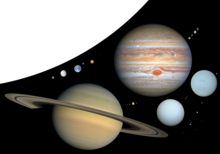
Back خط زمني لاكتشاف كواكب المجموعة الشمسية وأقمارها Arabic Cronologia del descobriment dels planetes del sistema solar i dels seus satèl·lits naturals Catalan Liste der Entdeckungen der Planeten und ihrer Monde German Κατάλογος χρονολογικής ανακάλυψης των πλανητών του Ηλιακού συστήματος και των δορυφόρων τους Greek Kronologio de la malkovroj de la sunsistemaj planedoj kaj de ties naturaj satelitoj Esperanto Anexo:Cronología del descubrimiento de los planetas del sistema solar y sus satélites naturales Spanish Zerrenda:Eguzki-sistema eta bertako sateliteen aurkikuntzaren kronologia Basque Chronologie des découvertes des satellites naturels du Système solaire French Cronoloxía do descubrimento dos planetas do sistema solar e os seus satélites naturais Galician Cronologia della scoperta di pianeti e satelliti del Sistema solare Italian
 |
| Objects |
|---|
| Lists |
| Planets |
|
|
The timeline of discovery of Solar System planets and their natural satellites charts the progress of the discovery of new bodies over history. Each object is listed in chronological order of its discovery (multiple dates occur when the moments of imaging, observation, and publication differ), identified through its various designations (including temporary and permanent schemes), and the discoverer(s) listed.
Historically the naming of moons did not always match the times of their discovery. Traditionally, the discoverer enjoys the privilege of naming the new object; however, some neglected to do so (E. E. Barnard stated he would "defer any suggestions as to a name" [for Amalthea] "until a later paper"[1] but never got around to picking one from the numerous suggestions he received) or actively declined (S. B. Nicholson stated "Many have asked what the new satellites [Lysithea and Carme] are to be named. They will be known only by the numbers X and XI, written in Roman numerals, and usually prefixed by the letter J to identify them with Jupiter."[2]). The issue arose nearly as soon as planetary satellites were discovered: Galileo referred to the four main satellites of Jupiter using numbers while the names suggested by his rival Simon Marius gradually gained universal acceptance. The International Astronomical Union (IAU) eventually started officially approving names in the late 1970s. With the explosion of discoveries in the 21st century, new moons have once again started to be left unnamed even after their numbering, beginning with Jupiter LI and Jupiter LII in 2010.
- ^ Cite error: The named reference
Barnard_1892was invoked but never defined (see the help page). - ^ Nicholson, Seth Barnes (April 1939). "The Satellites of Jupiter". Publications of the Astronomical Society of the Pacific. 51 (300): 85–94. Bibcode:1939PASP...51...85N. doi:10.1086/125010.
© MMXXIII Rich X Search. We shall prevail. All rights reserved. Rich X Search